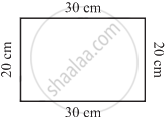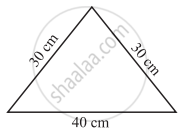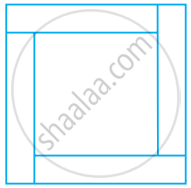Advertisements
Advertisements
Question
The length and the breadth of a conference hall are in the ratio 7: 4 and its perimeter is 110 m. Find:
(i) area of the floor of the hall.
(ii) a number of tiles, each a rectangle of size 25 cm x 20 cm, required for the flooring of the hall.
(iii) the cost of the tiles at the rate of ₹ 1,400 per hundred tiles.
Solution
Ratio in length and breadth = 7 : 4
Perimeter = 110 m
∴ Length + Breadth = `110/2 = 55` m
Sum of ratios = 7 + 4 = 11
∴ Length = `(55 xx 7)/11 = 35` m
and breath = `(55 xx 4)/11 = 20` m
(i)
Area of floor = l × b
= `35 xx 20 = 700 "m"^2`
(ii)
Size of tile = 25 cm × 20 cm
= `(25 xx 20)/(100 xx 100)`
= `1/20 "m"^2`
∴ Number of tiles
= `"Area of floor"/"Area of one tile"`
= `(700 xx 20)/1 = 14000`
(iii)
Cost of tiles = ₹ 1400 per 100 tiles
∴ Total cost = `(14000 xx 1400)/100`
= ₹ 196000
APPEARS IN
RELATED QUESTIONS
Find the perimeter of a rectangle whose:
length = 40 cm and breadth = 35 cm
A regular pentagon of each side 12 cm has same perimeter as that of a regular hexagon. Find the length of each side of the hexagon.
Look at the figures on the sheet of graph paper. Measure their sides with the help of the lines on the graph paper. Write the perimeter of each in the right box.

- Perimeter of rectangle ABCD = ______ cm.
- Perimeter of rectangle EFGH = ______ cm.
- Perimeter of square PQRS = ______ cm.
- Perimeter of rectangle STUV = ______ cm.
If every side of a rectangle is doubled, then its area becomes _______ times
How many different rectangles can be made with a 48 cm long string? Find the possible pairs of length and breadth of the rectangles.

Each rectangle is made out of 12 equal squares, so all have the same area, but the length of the boundary will be different.
Which of these rectangles has the smallest perimeter?
Length and breadth of a rectangular sheet of paper are 20 cm and 10 cm, respectively. A rectangular piece is cut from the sheet as shown in figure. Which of the following statements is correct for the remaining sheet?
A rectangular piece of land measures 0.7 km by 0.5 km. Each side is to be fenced with 4 rows of wires. What is the length of the wire needed?
What is the perimeter of the following figures? What do you infer from the answers?
 (a) |
 (c) |
 (b) |
 (d) |
A large square is made by arranging a small square surrounded by four congruent rectangles as shown in the given figure. If the perimeter of each of the rectangle is 16 cm, find the area of the large square.

